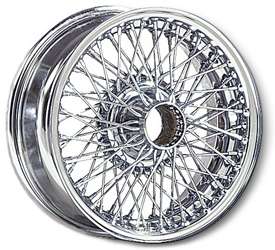The MGA With An Attitude
Wire Wheel HYDROGEN EMBRITTLEMENT - WL-121
On February 3, 2006, John H in Wisconsin wrote:
 "I have 72 spoke chrome Dunlops on our A. After several years they started to break at the bend at the hub end. They are not properly processed after chroming and are too brittle. I buy at least a half dozen new spokes each year."
"I have 72 spoke chrome Dunlops on our A. After several years they started to break at the bend at the hub end. They are not properly processed after chroming and are too brittle. I buy at least a half dozen new spokes each year."
This is a very short note, but demands a stage of its own. Given a choice, avoid chrome over steel spokes in wire wheels, as hydrogen embrittlement is a problem. Get either stainless steel spokes or chrome over stainless. British Wire Wheel offers a number of options for stainless or chrome over stainless spokes. They also offer a tubeless wire wheel option with sealed rims (which I highly recommend as I hate tubes).
Side note here: I will repeat this many times. All original MGA wheels were painted. Chrome wire wheels have always been aftermarket accessory parts. That said, they are period correct aftermarket accessories, and have been gaining popularity in more recent times. Scoring points or losing points in a car show would depend on the judging style. Popular vote or exhibitor's choice will often favor over-restored cars with chrome wire wheels and gloss black chassis paint. I have no idea how few MGA would ever be entered in a true concours show where points may be deducted for chrome wheels.
Addendum January 2010:
On popular demand, more information about hydrogen embrittlement. But first, one quick related note about stainless steel spokes:
Stainless steel is commonly misunderstood. It is very similar to mild steel, except it as come Nickel added (among other trace elements) to reduce corrosion. Like non-stainless products, there are various alloys of stainless that will be stronger than mild steel, but simply making it "stainless" does not affect the mechanical properties very much. Stainless steel may be slightly trickier for machining, but it is not stronger or tougher or more brittle simply because it is stainless. It can make for very good wheel spokes.
Now back to the subject at hand. Hydrogen embrittlement is a well know killer of chrome plated spokes. There are techniques for minimizing effects of hydrogen embrittlement during the plating process. Apparently a lot of current plating shops are lax in those practices, because there have been very many recent reports of broken spokes in fairly new chrome plated wire wheels. The situation has been so bad in recent years that if I was buying wire wheels I would never accept chrome plated spokes. Not that it can't be done, just that I have no way of knowing who might make good ones as opposed to the host of bad ones flooding the current market. As form follows function, I am delighted to see chrome wire wheels with stainless steel spokes (even though I think chrome looks gaudy on an MGA).
We are likely more familiar with plating of steel bumpers and trim rings for lights, which is similar process. Original chrome on these cars may last 40-50 years and still be in serviceable condition. The process is commonly referred to as "triple chrome plating". First lay down a generous layer of copper to "seal" the steel surface and make a good bonding surface for the outer metals. Then lay on a generous layer of nickel plating for the thickness and durability (as nickel is cheaper than chrome in quantity). Finally lay on the chrome, not thick nor thin, but enough to look good and polish out well without wearing thin. If it doesn't look good or last long it needs more chrome.
There are many pitfalls in modern day processing, and I'm pretty sure that most are driven by economy (trying to keep the cost to a minimum). I suspect the first and most egregious problem is not using enough copper (which is relatively cheap compared to nickel or chrome). A very thin layer of copper is enough to provide good adhesion for the outer metals, but being too thin it may leave the steel somewhat permeable, which is when the hydrogen can sneak in during following processing to make the steel brittle. Whatever comes after that is more a matter of aesthetic appearance and durability, but I think the hydrogen embrittlement problem comes early in the process. Put enough copper in the initial layer and nothing more will get to the steel during subsequent plating processes.
Not being a metallurgist, I can't swear there aren't some issues with the steel alloy that could cause embrittlement during the copper plating process. The point is that brittle chrome spokes were very rare in past years but are very common now. The materials used have not changed, so the fault is obviously in the processing techniques and/or cheating on the amount of materials. Apparently no one is willing to put in the little extra time and materials to do plating that is intended to last 50 years in normal use, and the shortcuts lead to this "modern" hydrogen embrittlement problem.
|